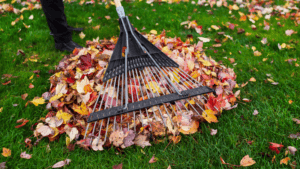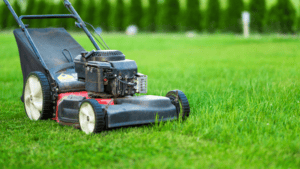The air is crisp, the leaves are falling and pumpkins are everywhere. It’s finally time to store your lawnmower away for the winter. If you do not expect Santa to bring you a new lawnmower for Christmas you will want to store it properly so that it starts up for you again next spring. Here are common mistakes to avoid when storing your lawn mower.
- Not reading the owner’s manual.
First thing’s first. You want to follow the manufacturer’s directions for maintenance on your specific equipment. It also provides important user safety instructions. For example, always wear gloves when completing maintenance and repair work. It is recommended that the spark plug wire and boot be removed to prevent accidental starting and potential danger. Your owner’s manual will also provide instructions for the best way to store your mower over the winter months.
- Not taking time to thoroughly clean.
Grass and debris may build up near components and need to be removed before storing. In lawn mowers, the debris builds up in the deck and undercarriage which can cause issues next spring. Clean down to the painted metal with a hose, a putty knife and a small amount of car wash detergent.
- Not treating fuel in the tank.
If you leave untreated fuel in the gas tank this winter, the gas will begin to corrode and form deposits in the fuel tank, fuel lines, filter, and carburetor. Before you store your mower, mix stabilizer with fresh gas and fill the tank. Let it run long enough to make sure the stabilized gas has worked through the fuel lines and carburetor. Top off the tank so that there is little room for the gas to expand or water vapor to possibly contaminate the fuel.
- Not disconnecting the battery.
Vampire Power or Standby Power occurs on riding mowers and zero turns. Even when the machine is off, a small amount of power can still be pulled from a battery that is connected. During the winter, when you are storing for a long time, disconnect the battery and keep it in cool, dry place. This will help lower the rate of your battery’s discharge.
- Not changing the oil.
Old used oil has contaminants that are bad to leave in your engine for the winter. Also, it saves you time on the spring tune-up next year and helps to make sure your engine is lubricated properly from the beginning of the season.
- Not lubricating.
Use a silicone spray or WD-40 lubricant on and exposed bare metal, especially the undercarriage of the lawn mower. Check for oil stains and use degreaser on any you find. It takes 10-15 minutes for the degreaser to work and then you can wipe clean with a cloth and spraying with the hose.
- Not checking for damaged parts.
Now is a great time to inspect your equipment for damage and replace any part needed, as you can take your time and not rush to be able to mow again. Warped or bent mower blades should be replaced to prevent prematurely-worn bearings and more serious safety issues. Now would also be a great time to troubleshoot any performance issues.
Another thing to remember for winter is to store your mower in a dry, covered area like a shed or garage. Storing a mower outside, more common with riding mowers, is not a good idea, even when you cover it to protect it from the winter climate. Often water makes its way into the gas tank and starts issues so whenever possible store your mower inside.
Follow these steps and any additional ones from the owner’s manual so that you will be ready for the spring thaw and the first spring mow.



